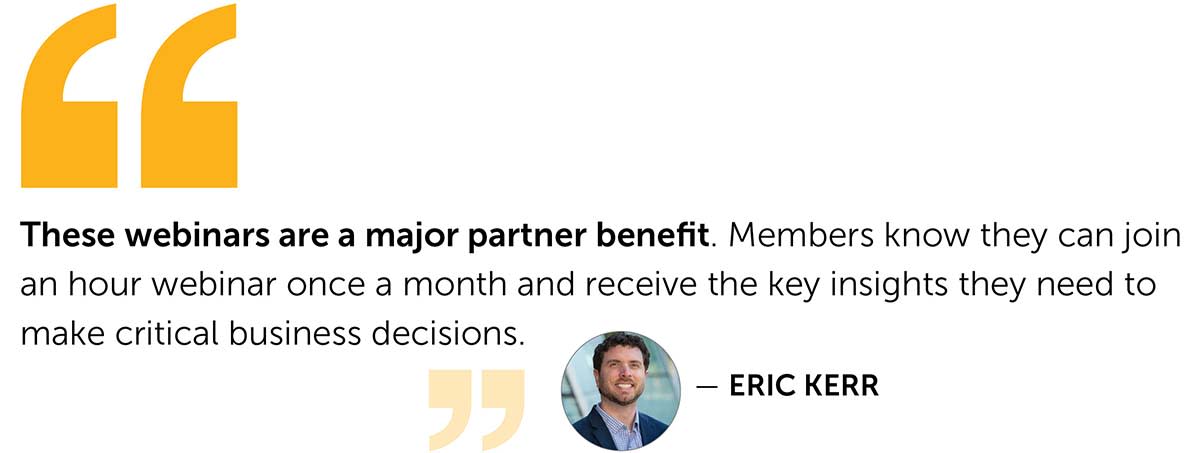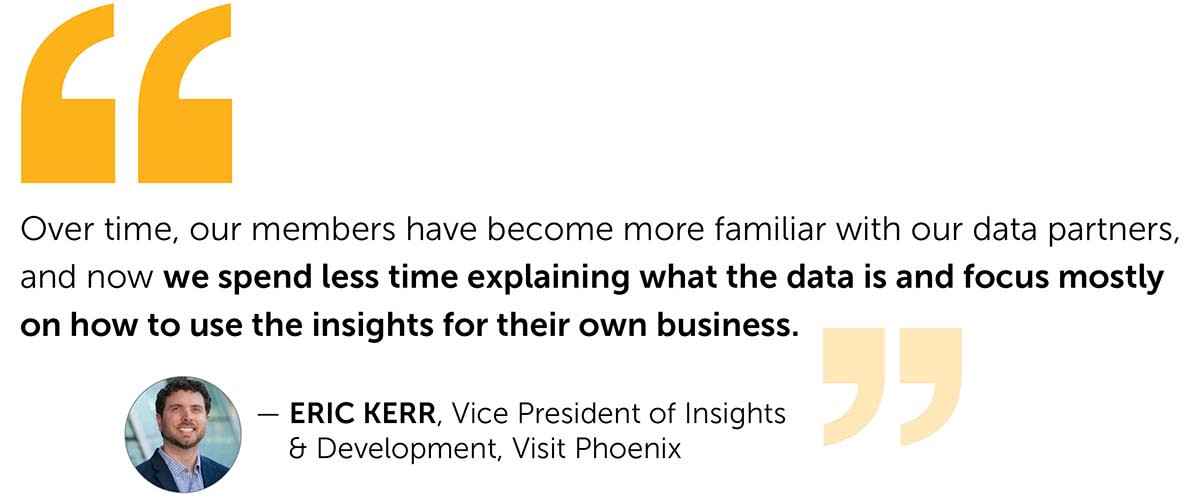When March 2020 sparked its massive disruption to travel and tourism, two things businesses in Phoenix needed more than anything were good information and accurate data. For that, they turned to Visit Phoenix.
The destination marketing organization (DMO) began holding a monthly webinar for members to provide them with data they couldn’t get anywhere else. Three years later, the webinars are still being held and have an average of 90 members attending.
We spoke with Eric Kerr, vice president of insights & development at Visit Phoenix, about the webinars and asked him for tips on how other DMOs could emulate what’s proven to be a popular member offering.
 What sparked the idea to start hosting/producing monthly webinars focusing on business intelligence for Visit Phoenix members?
What sparked the idea to start hosting/producing monthly webinars focusing on business intelligence for Visit Phoenix members?
![]() Before the pandemic, we were already enhancing our research programs with geolocation services, vacation rental data, visitor profiles, and hotel performance. As a service for members, we shared our findings through newsletters and annual in-person events.
Before the pandemic, we were already enhancing our research programs with geolocation services, vacation rental data, visitor profiles, and hotel performance. As a service for members, we shared our findings through newsletters and annual in-person events.
When the pandemic started, our members were emailing and calling, needing information regarding event cancellations, hotel closures, and which drive markets to potentially target. Back then, things were changing rapidly. We saw it as our responsibility to provide the most up-to-date information possible so partners could make the best business decisions they could.
In-person events were difficult to host and, at that time, could not be held, but we needed a way to share insights with our many partners regularly. Hosting a monthly webinar would let us share our expertise and address multiple member questions and concerns at once.
 You hosted 14 webinars in fiscal year 2020-2021 with an average attendance of more than 90 members. What sort of data do you share?
You hosted 14 webinars in fiscal year 2020-2021 with an average attendance of more than 90 members. What sort of data do you share?
![]() In all our webinars, we make it a point to feature hotel, airport, search, and booking activity. These basic industry statistics are important for showing the overall health of the destination. Updates on these areas can also provide jumping-off points for deeper discussion to dive more granularly into.
In all our webinars, we make it a point to feature hotel, airport, search, and booking activity. These basic industry statistics are important for showing the overall health of the destination. Updates on these areas can also provide jumping-off points for deeper discussion to dive more granularly into.
National and international visitor industry research firms stepped up in big ways during the pandemic, providing weekly and monthly updates on visitor sentiment and intent. Our localized webinar could not have started without insights from companies like Destination Analysts, Longwoods International, MMGY, and Miles Partnership. Key travel topics, trend charts on intent, perceptions on travel safety, and resources showing general traveler behavior all had a hand in how we shaped the webinars to show the most relevant information to support our members.
Early on, we featured such measurements as: how many passengers passed through Sky Harbor TSA, flight search and booking trends for Phoenix from Sojern, and search levels for activities in Phoenix like parks and retail from Google. We even featured data from OpenTable that we charted to visibly show the recovery of seated diners in Greater Phoenix area restaurants. Many of these tools were new and free, but our partners didn’t know they existed.

As the market started to improve, we began focusing on specific areas of recovery and how our members could utilize the more granular information. We used road trip tracker and geolocation tools to show who was still traveling into the market and from where.
With so much data at our fingertips, we segmented our webinars to focus on either leisure travel trends or group and convention trends. For the convention-focused webinar, we referenced resources like our FuturePace reports by 2Synergize to identify hotel room and attendee need periods in otherwise strong years, and NorthStar’s Pulse surveys. During these webinars, we also provided an analysis of recent lead and booking production, providing members with figures on top market segments, origin markets, lead sizes, and changes from previous years.
We also take the time to track down and highlight the largest events taking place in our market. This is a great way to prepare our members for potential compression in the market, especially as these events continue to return to full attendance levels.
In 2021, we began using the Tourism Economics Symphony platform to consolidate our data resources, provide new insights, and create more compelling visualizations to share with our partners. This tool has been instrumental in enhancing these webinars.
 How have the meetings evolved and what feedback have you received from attending members? How much of a teaching component is there in terms of helping members understand how to use the data you provide?
How have the meetings evolved and what feedback have you received from attending members? How much of a teaching component is there in terms of helping members understand how to use the data you provide?
![]() In the beginning, we held more general webinars where we gave insights into many facets of the industry. After member feedback, we decided to focus on a featured topic each time, and now we rotate between convention, leisure travel, and events. There are some stats we include each time, but the bulk of each webinar is tailored to a specific topic, so members who are interested know they’ll get all the information they need.
In the beginning, we held more general webinars where we gave insights into many facets of the industry. After member feedback, we decided to focus on a featured topic each time, and now we rotate between convention, leisure travel, and events. There are some stats we include each time, but the bulk of each webinar is tailored to a specific topic, so members who are interested know they’ll get all the information they need.
Over time, our members have become more familiar with our data partners, and now we spend less time explaining what the data is and focus mostly on how to use the insights for their own business.
 In the realm of offerings to your members, where would you say these business intelligence meetings fall in terms of value and importance?
In the realm of offerings to your members, where would you say these business intelligence meetings fall in terms of value and importance?
![]() When we first started the webinars, it was to increase contact and share expertise with our partners at a time when in-person events could not occur. Now, these webinars are a major partner benefit. Members know they can join an hour webinar once a month and receive the key insights they need to make critical business decisions.
When we first started the webinars, it was to increase contact and share expertise with our partners at a time when in-person events could not occur. Now, these webinars are a major partner benefit. Members know they can join an hour webinar once a month and receive the key insights they need to make critical business decisions.
We’ve also encouraged our partners to provide feedback in post-event surveys. We’ve adjusted content based on these surveys. Feedback in post-event surveys has also been great — we are averaging a Net Promoter Score of more than 80 over the last year for our Trends webinars.

We’ve heard multiple members mention they’ll be able to use the data we provide to assist with their strategic business plans for the year. We let our members know when the market will be soft or strong based on events demand, where can they consider target marketing, and what market segments or demographics are coming into the market, among other useful information. This provides huge value to the businesses that did not have these tools available to them prior to the webinars.
 What advice do you have for other DMOs who might consider offering something similar?
What advice do you have for other DMOs who might consider offering something similar?
![]() Avoid “data dumping” to your attendees. There are instances when it’s relevant to show a slide with a lot of data points in it, but it’s important to interpret the bigger story on the page for attendees. Also, consider segmenting topics and rotating topics monthly, like conventions, leisure, international, and accommodations. Your partners will start to have different staff attend different webinars.
Avoid “data dumping” to your attendees. There are instances when it’s relevant to show a slide with a lot of data points in it, but it’s important to interpret the bigger story on the page for attendees. Also, consider segmenting topics and rotating topics monthly, like conventions, leisure, international, and accommodations. Your partners will start to have different staff attend different webinars.
Include a post-event survey. This feedback is valuable when it comes to adjusting the content to best suit the needs of your attendees. It’s also a great way to receive suggestions for topics you may not have thought about covering.
 What do you wish you’d known going in that could help others?
What do you wish you’d known going in that could help others?
![]() One thing we wish we had known in the beginning was how many free resources were available to us. Destinations could potentially build presentations using freely available third-party sources. OpenTable, Google Trends, Arrivalist, Google Travel Insights, Transportation Security Administration (TSA), and Throughput were all free resources we used in the beginning that provide data specific to your destination.
One thing we wish we had known in the beginning was how many free resources were available to us. Destinations could potentially build presentations using freely available third-party sources. OpenTable, Google Trends, Arrivalist, Google Travel Insights, Transportation Security Administration (TSA), and Throughput were all free resources we used in the beginning that provide data specific to your destination.

